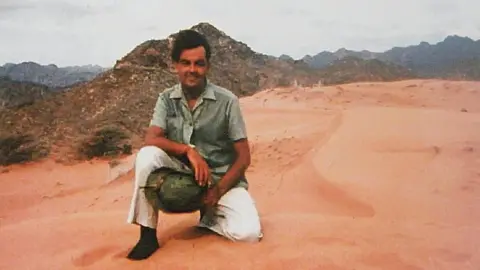Nuclear test 'cloud sampler' living with PTSD decades on
 BNTVA
BNTVAA nuclear veteran who was part of a crew tasked with flying a plane through a mushroom cloud has told how he still lives with "shell shock" decades on.
John Folkes remembers looking down into an "inferno" before the nuclear blast's force flipped the plane in 1956.
A charity has now re-applied for medals for those who helped build Britain's weapons, after its last bid failed.
The Cabinet Office thanked the veterans for their contribution but said it fell outside criteria for medal recognition.
Mr Folkes, 85, from Ramsgate, Kent, who witnessed seven tests in Maralinga in 1956 and still lives with a hand tremor - a symptom of post-traumatic stress disorder - told how the gauges went off the scales as the aircraft flew towards the radioactive blast.
He was one of a number of RAF cloud samplers who took readings from the air of radioactive fallout, after bombs were detonated.
A 19-year-old aircraft technician at the time, he remembers an inferno "mixed with a crimson and blackened thick cloud of billowing smoke" climbing towards them.
He said the plane leaked radiation "like a sieve" because he could feel the draughts coming through the doors.
He went on to serve in the RAF for 30 years but has never forgotten the "shattering" ordeal, which he documented in detail in a diary at the time, and said he is only seeking recognition.
Mr Folkes said he was aware of the dangers in 1956 following the bombs dropped at Hiroshima and Nagasaki, but "pushed it to the back of his mind".
The BNTVA (British Nuclear Test Veterans' Association) has set out how about 22,000 personnel witnessed tests in Australia, the Montebello Islands off Western Australia and Christmas Island in the South Pacific, in the 1950s and 1960s.
In its application for medal recognition, which includes Mr Folkes's account, the charity said many personnel were teenagers after thousands had been conscripted into National Service.
The BNTVA said many went on to suffer health problems including rare cancers, infertility, musculoskeletal issues and digestive problems, attributed to the bomb tests.
Academic Fi Bowler said at the time of the tests it was thought there was a threshold dose that left virtually no ill-effects, but added: "The consensus now is there is no level of safe radiation exposure."
Ms Bowler also said evidence had existed from 1947 discrediting the "safe" dose theory.
BNTVA chairwoman Ceri McDade said the application for medal recognition was not about radiation readings, which were not always recorded.
She said the submission was based on "the physical risk, and physical and mental rigour associated with enduring the detonation of multiple nuclear experiments at close quarters".
She added: "The transgressive act of participating in the nuclear tests was way beyond their call of duty, and has exacerbated feelings of guilt, shame, injustice and anger ever since."
A Cabinet Office spokeswoman said: "We are grateful to all those who participated in the British nuclear testing programme, which played a valuable role towards developing a nuclear deterrent that has ultimately kept Britain safe for decades.
"While it falls outside the criteria for medallic recognition, this in no way diminishes the contribution of those service personnel who witnessed the UK's nuclear tests."

Follow BBC South East on Facebook, on Twitter, and on Instagram. Send your story ideas to [email protected]
